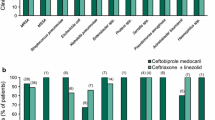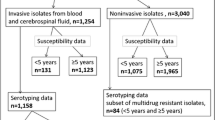Summary
Penicillin resistance occurred soon after the discovery of penicillin, first in the test tube and subsequently in patients. The prevalence of invasive pneumococcal disease has been estimated to be as high as 15–18/100,000 in the elderly population and even higher in AIDS patients, children and the very old. While prevention with pneumococcal vaccine seems the most reasonable solution, under-utilization of the vaccine and an increase in the number of immuno-compromised individuals has limited the success of this approach.Streptococcus pneumoniae is conventionally classified as penicillin-susceptible (MIC<0.125 mg/l), penicillin-intermediate (MIC 0.125–1.0 mg/l) and penicillin-resistant (MIC≥2 mg/l). In many countries, penicillin resistance in pneumococci is on the increase and in some areas penicillin intermediate and resistant isolates reach 60%. As a consequence, a switch of therapy from penicillin to other agents is mandatory in infections caused by penicillin-resistant strains. Benzylpenicillin, however, can be used for most infections caused by penicillin-intermediate and all infections caused by penicillin-sensitive strains. Third generation cephalosporins, and in particular cefotaxime, are an optional alternative, particularly in view of their low MICs against penicillin-susceptible and -intermediate and some penicillin-resistant strains, and the easily achievable therapeutic concentrations in serum, pulmonary tissues and other compartments in which penumococcal infections occur. Third generation cephalosporins have a high safety record and can be administered to children, pregnant women and the elderly. Their relatively low price is an important aspect. Ceftazidime and ceftizoxime should not be used, however, because of their high MICs against penicillin resistant strains.
Zusammenfassung
Resistenz gegen Penicillin trat schon bald nach seiner Entdeckung auf und wurde zunächstin vitro und dann bei Patienten beobachtet. Die Prävalenz invasiver Pneumokokkeninfektionen wird in der älteren Bevölkerung auf 15–18/100.000 geschätzt. Bei AIDS-Kranken, Kindern und sehr alten Menschen liegt sie noch darüber. Die vernünftigste Lösung ist die Prävention durch Pneumokokkenvakzine, doch wird diese zu wenig eingesetzt und die zunehmende Anzahl abwehrgeschwächter Personen hat den Erfolg dieses Ansatzes begrenzt. Die konventionelle Klassifizierung der Pneumokokken sieht eine Einteilung in penicillinempfindliche (MHK<0,125 mg/l), mäßig empfindliche (MHK 0,125 – 1 mg/l) und resistente Stämme (MHK>2 mg/l) vor. In vielen Ländern nimmt Penicillin-Resistenz beiStreptococcus pneumoniae zu. In manchen Gegenden hat der Anteil mäßig empfindlicher oder resistenter Stämme 60% erreicht. Folglich muß für die Behandlung von Infektionen durch penicillinresistente Stämme Penicillin durch eine Alternativsubstanz ersetzt werden. Allerdings kann Benzylpenicillin bei Infektionen durch mäßig empfindliche Stämme eingesetzt werden, und es ist indiziert bei allen Infektionen durch penicillinempfindliche Pneumokokken. Cephalosporine der dritten Generation — insbesondere Cefotaxim — stellen eine Alternative dar. Sie weisen gegen penicillinempfindliche und mäßig empfindliche sowie einige penicillinresistente Stämme niedrige MHK-Werte auf. Sie erreichen in Serum, Lungengewebe und anderen Kompartimenten, in denen Pneumokokkeninfektionen auftreten, problemlos therapeutische Konzentrationen. Sie sind sehr sichere Medikamente und können bei Kindern, schwangeren Frauen und alten Patienten eingesetzt werden. Ein wichtiger Aspekt ist ihr relativ niedriger Preis. Ceftazidim und Ceftizoxim sollten allerdings wegen der hohen MHK-Werte gegen penicillinresistente Pneumokokken nicht gegeben werden.
Similar content being viewed by others
References
Watson, D. A., Musher, D., Jacobson, J. W., Verhoef, J. A brief history of the pneumococcus in biomedical research: a study of scientific discovery. Clin. Infect. Dis. 17 (1993) 913–924.
Austrian, R. Random gleanings from a life with thePneumococcus. J. Infect. Dis. 131 (1975) 474–484.
Hansmann, D., Glasgow, H., Sturt, J., Devitt, L., Douglas, R. Increased resistance to penicillin of pneumococci isolated from man. N. Engl. J. Med. 284 (1971) 175–177.
Appelbaum, P. C., Bham Jee, A., Scragg, J. N., Hallett, A. F., Bowen, A. J., Cooper, R. C. Streptococcus pneumoniae resistant to penicillin and chloramphenicol. Lancet ii (1977) 955–957.
Riley, I. D., Douglas, R. M. An epidemiologic approach to pneumococcal disease. Rev. Infect. Dis. 3 (1981) 233–245.
Rodriguez-Berradus, M. C., Musher, D. M., Lahart, C., Lacke, C., Groover, J. Antibody to capsular polysaccharides ofStreptococcus pneumoniae after vaccination to HIV infected subjects with 23 -valent pneumococcal vaccine. J. Infect. Dis. 16 (1992) 553–556.
Austrian, R. The assessment of pneumococcal vaccine. N. Engl. J. Med. 303 (1981) 578–579.
Broome, C. V., Breiman, R. F. Pneumococcal vaccine — past, present and future. N. Engl. J. Med. 325 (1991) 1506–1507.
Quick, R. E., Hoye, C. W., Hamilton, D. J., Whitney, C. J., Borges, M., Kobayashi, J. M. Under-utilization of pneumococcal vaccine in nursing homes in Washington State: report of a serotype specific outbreak and survey. Am. J. Med. 94 (1993) 149–152.
Anonymous: Penicillin resistant Pneumococcus. MMWR 143 (1994) 29.
Pallares, R., Guidol, F., Linares, J., Aziza, J., Rufi, G., Margui, L., Dorca, J., Viladrich, P. F. Risk factors and response to antibiotic therapy in adults with bacteremic pneumonia caused by penicillin-resistant penumococci. N. Engl. J. Med. 317 (1987) 18–22.
Rubinstein, E., Sofin, M.: Community acquired pneumonia: approaches to clinical management and economic cost-containment in the 1990's. Eur. Resp. Rev. J. 4 (1994) (in press).
Finland, M. And the walls came tumbling down. N. Engl. J. Med. 284 (1971) 770–771.
Anonymous: Recommendations regarding penicillin resistant pneumococcal disease — Spain. MMWR 41 (1992) 500–501.
Mandel, D. R., Moorman, G. L. Characteristics of rifampin-resistant variants obtained from clinical isolates ofStaphylococcus aureus. Antimicrob. Agents Chemother. 20 (1981) 709–713.
Carbon, C., Rubinstein, E. Bacterial pneumonia. In:Neu, H. C., Young, L. S., Zinner, S. H. (Eds.): The new macrolides, azalides and staphogranins. Pharmacology and clinical applications. Marcel Dekker Inc., New York 1993, pp. 129–136.
Anonymous: Penicillin resistant Pneumococcus. MMWR 38 (1989) 733.
Simberkoff, M. S., Lukaszewski, M., Cross, A., Al-Ibrahim, M., Baltoh, A. L., Smith, R. P., Geisler, P. J., Nadler, J., Richmond, A. S. Antibiotic resistant-isolates ofStreptococcus pneumoniae from clinical specimens: a cluster of serotype 19A organisms in Brooklyn, New York. J. Infect. Dis. 153 (1986) 78–82.
Garcia-Leoni, E. M., Cercenado, E., Rodeno, P., Bernaldo-de-Quiros, J. C., Martinez-Hernandez, D., Bovza, E. Susceptibility ofStreptococcus pneumoniae to penicillin: a prospective microbiological and clinical study. Clin. Infect. Dis. 14 (1992) 427–435.
Viladrich, P. F., Guidol, F., Linares, J., Rufi, G., Ariza, J., Pallares, R. Characteristics and antibiotic therapy of adult meningitis due to penicillin resistant pneumococci. Am. J. Med. 84 (1988) 839–846.
Koornhof, H. J., Klugman, K. Antimicrobial resistance inStreptococcus pneumoniae: a South African perspective. Clin. Infect. Dis. 15 (1992) 84–94.
Author information
Authors and Affiliations
Rights and permissions
About this article
Cite this article
Rubinstein, E., Rubinovitch, B. Treatment of severe infections caused by penicillin-resistant pneumococci. Role of third generation cephalosporins. Infection 22 (Suppl 3), S161–S166 (1994). https://doi.org/10.1007/BF01782701
Issue Date:
DOI: https://doi.org/10.1007/BF01782701




